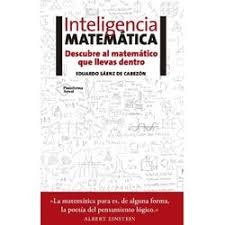
Idioma original: castellano
Year of publication: 2016
Valuation: recommended, if you dare
I have to confess that I met Eduardo Sáenz de Cabezón through Tiktok, where he talks about mathematics, which is his thing. He is a guy with a good ability to communicate, and I think he also has, or had, a programme on scientific matters on television. There are a few popularisers in the media who are dedicated, with greater or lesser success, to bringing people closer to the unknown world of mathematics and, of course, it is difficult to resist the temptation to try once again, to find another way to reach that which was slipping through our fingers when the exams were approaching. So we tried it with this nice gentleman, to see if we were lucky.
Sáenz de Cabezón says that we all have a mathematician inside us, even if it is often dormant or defeated by laziness, even atrophied by inactivity, or also, I would add, disappeared without a trace. It is therefore a matter of removing it from its redoubt and seducing it to start working. Once activated, it seems, practice itself will make it grow and become agile. At least in theory. That is why the author strives to propose games, pastimes, small exercises to wake up the hidden mathematician. I swear that I have done some (two) and I have dedicated a few minutes to some others (let’s say another two), but I consider that I have failed, because my mathematician has not made an appearance.
The truth is that it is a bit annoying to feel incapable of reasonings that, in the words of the popularizer on duty, seem so simple. In reality, you would only have to think a little to unravel some of the questions, at least the simplest ones. Let’s take an example, which I think is identical to the one that appears in the book:

I think the question is which of the surfaces, circle or square, is bigger. We work on radii and sides, we extract triangles and deduce similarities, we obtain areas, differences… and it turns out that there is not one, but several valid procedures to obtain the correct answer. It is easy when we see the video where the teacher explains with blue and red markers, names a segment as X and applies formulas (that should have been) learned in Primary School. But when one sees the blank image and has to get down to it, things don’t look so good. The same thing happened in the exam.
The book criticises an educational system that is incapable of making the learning of mathematics even minimally attractive, in which knowledge is only accumulated in techniques whose usefulness the student, naturally, does not understand. And as these techniques are linked one after another, it is enough for one of the links to fail for the process to be blocked and the student immediately switches to Latin, not because he has a special interest in the language of Virgil, but for mere survival. Sáenz de Cabezón offers some ideas for improving the teaching of these subjects, although I allow myself to doubt the success in the face of a problem to which no one seems to have found a solution, at least in Spain, as far as I know.
In mathematics, things like logic and a certain capacity for generalization and abstraction are handled, qualities that not everyone possesses (or that are hidden, I don’t know), and in the educational system, mechanisms and techniques are explained, which are what is examined, but which do not work without those basic assumptions, which would therefore be what should be awakened in students.
The author attempts to do so by posing very simple questions to seduce the layman, and also by presenting others (hypotheses and unresolved conjectures) that illustrate the work of mathematicians. He also exposes the auxiliary nature of mathematics, whose discoveries serve to resolve pending questions in other sciences or open new paths within the different areas of this field. Matters are generally well explained, in a tone that is perhaps excessively colloquial, more appropriate for the audiovisual media where Sáenz de Cabezón works, and not so much, or so it seems to me, for a book.
But well, nice and with the laudable intention of attracting us to those subjects that made some of us sweat so much and with which I fear that, no matter how much good will we put into it, we will hardly be able to win over. But in any case, the attempt is appreciated.
Source: https://unlibroaldia.blogspot.com/2024/09/eduardo-saenz-de-cabezon-inteligencia.html


